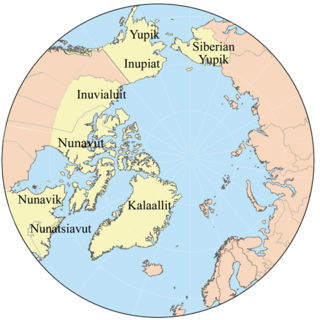It has been requested that the title of this article be changed to Chevak Cup'ik language . Please see the relevant discussion on the discussion page. The page should not be moved unless the discussion is closed; summarizing the consensus achieved in support of the move. |
| Chevak Cupʼik | |
|---|---|
| Cugtun | |
| Native to | United States |
| Region | Central Alaska (Chevak) |
| Ethnicity | Cupʼik |
Eskimo–Aleut
| |
| Latin | |
| Language codes | |
| ISO 639-3 | – |
esu-hoo | |
| Glottolog | None |
Chevak Cupʼik or just Cupʼik (and sometimes Cugtun) is a subdialect of Hooper Bay–Chevak dialect of Yupʼik spoken in southwestern Alaska in the Chevak (Cupʼik, Cevʼaq) by Chevak Cupʼik Eskimos (own name Cupʼit or Cevʼallrarmuit). [1] [2] [3] The speakers of the Chevak subdialect used for themselves as Cupʼik (as opposed to Yupʼik), but the speakers of the Hooper Bay subdialect used for themselves as Yupʼik (not Cupʼik), as in the Yukon-Kuskokwim dialect.
Central Alaskan Yupik, or Yupʼik is one of the languages of the Yupik family, in turn a member of the Eskimo–Aleut language group, spoken in western and southwestern Alaska. Both in ethnic population and in number of speakers, the Central Alaskan Yupik people form the largest group among Alaska Natives. As of 2010 Yupʼik was also the second-largest aboriginal language in the United States in terms of numbers of speakers. Yupʼik should not be confused with the related language Central Siberian Yupik spoken in Chukotka and St. Lawrence Island.

Alaska is a U.S. state in the northwest extremity of North America, just across the Bering Strait from Asia. The Canadian province of British Columbia and territory of Yukon border the state to the east, its most extreme western part is Attu Island, and it has a maritime border with Russia to the west across the Bering Strait. To the north are the Chukchi and Beaufort seas—southern parts of the Arctic Ocean. The Pacific Ocean lies to the south and southwest. It is the largest U.S. state by area and the seventh largest subnational division in the world. In addition, it is the 3rd least populous and the most sparsely populated of the 50 United States; nevertheless, it is by far the most populous territory located mostly north of the 60th parallel in North America: its population—estimated at 738,432 by the United States Census Bureau in 2015— is more than quadruple the combined populations of Northern Canada and Greenland. Approximately half of Alaska's residents live within the Anchorage metropolitan area. Alaska's economy is dominated by the fishing, natural gas, and oil industries, resources which it has in abundance. Military bases and tourism are also a significant part of the economy.

Chevak is a city in Kusilvak Census Area, Alaska, United States. At the 2010 census the population was 938, up from 765 in 2000.
Contents
- Education
- Vocabulary comparison
- Phonology
- Russian loanwords
- The names of days and months
- See also
- References
- External links
The Central Alaskan Yupik who in the village of Chevak call themselves Cupʼik (plural Cupʼit), whereas those who live on Nunivak Island (Nuniwar in Nunivak Cupʼig, Nunivaaq in Central Yupʼik) call themselves Cupʼig (plural Cupʼit), the spelling differences serving as a self-designated cultural identifier between the two groups. In both dialects, the consonant Yupʼik c is pronounced as an English ch. The Cupʼik dialect is readily distinguished from other dialects of Yupʼik in the pronunciation of Yupʼik "y" sounds as "ch" sounds (represented by the letter "c"), and by some fundamental differences in the basic vocabulary.

Nunivak Island, the second largest island in the Bering Sea, is a permafrost-covered volcanic island lying about 30 miles (48 km) offshore from the delta of the Yukon and Kuskokwim rivers in the state of Alaska, at about 60° North latitude. Nunivak Island is 1,631.97 sq mi in area, 76.2 kilometers (47.3 mi) long and 106 kilometers (66 mi) wide, making it the eighth largest island in the United States. It has a population of 191 persons as of the 2010 census, down from 210 in 2000. The island's entire population lived in the north coast city of Mekoryuk.
The oldest fully bilingual person in Chevak is Leo Moses, born in 1933; there are few if any persons born after 1945 who do not speak English. [1]
The first documentation of the Hooper Bay-Chevak dialect (beyond occasional citations) is found in the unpublished notes of Jesuit priests residing ay Hooper Bay and Kashunuk in the 1920s and 1930s. Published recognition of Hooper Bay-Chevak as a morphologically distinct dialect of Yupʼik seems to begin with Michael E. Krauss in 1973, [4] although the fundamental differences between the dialects were common knowledge among native speakers. [1] Cup'ik is a critically threatened language, and English the primary language of everyday communication among most of those with knowledge of the language.

Michael E. Krauss is an American linguist, professor emeritus, founder and long-time head of the Alaska Native Language Center. As of February 2013, the Alaska Native Language Archive is named after him.










